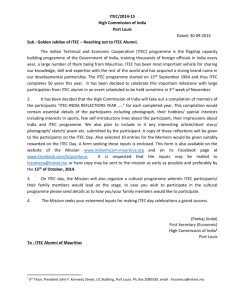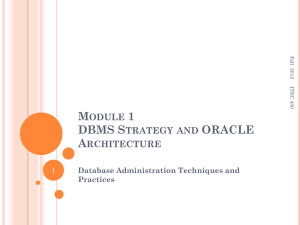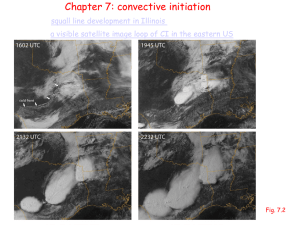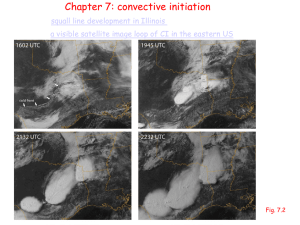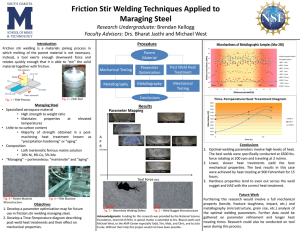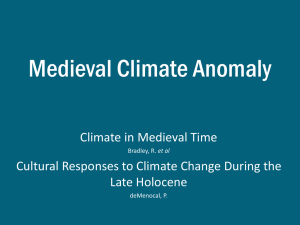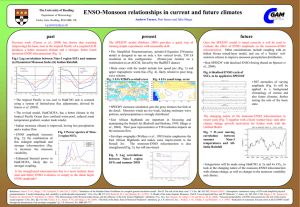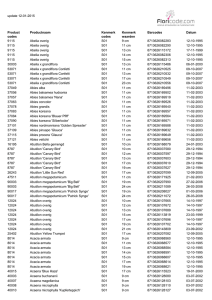Mosert_LISN2
advertisement
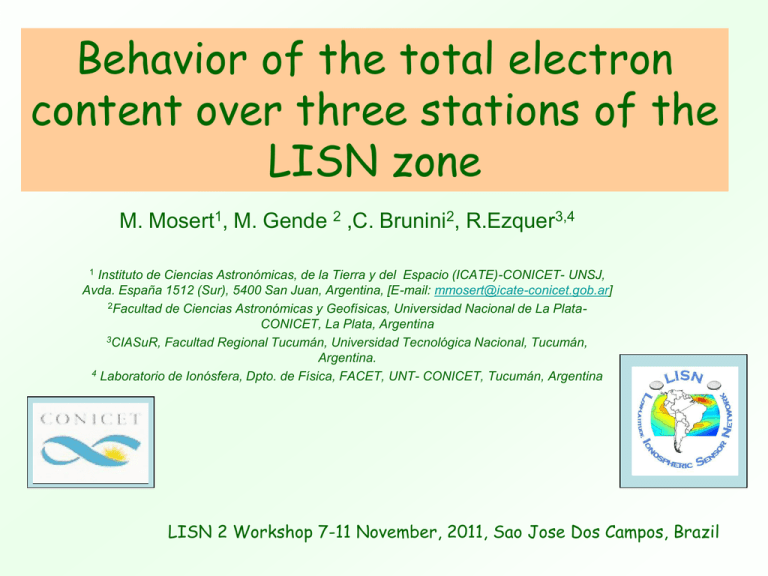
Behavior of the total electron content over three stations of the LISN zone M. Mosert1, M. Gende 2 ,C. Brunini2, R.Ezquer3,4 1 Instituto de Ciencias Astronómicas, de la Tierra y del Espacio (ICATE)-CONICET- UNSJ, Avda. España 1512 (Sur), 5400 San Juan, Argentina, [E-mail: mmosert@icate-conicet.gob.ar] 2Facultad de Ciencias Astronómicas y Geofísicas, Universidad Nacional de La PlataCONICET, La Plata, Argentina 3CIASuR, Facultad Regional Tucumán, Universidad Tecnológica Nacional, Tucumán, Argentina. 4 Laboratorio de Ionósfera, Dpto. de Física, FACET, UNT- CONICET, Tucumán, Argentina LISN 2 Workshop 7-11 November, 2011, Sao Jose Dos Campos, Brazil In this talk We analyze the behavior of total electron content using data from Jicamarca (-12.0°S; 283°E); Tucuman (-26.9°S; 294.6°E) and El Leoncito, San Juan (-31.5°S; 290.4°E). The database includes TEC measurements obtained from Digisonde observations (ITEC) and GPS signals (GPSTEC). The day to day variability is analyzed. Comparisons between observations and the IRI –2007 predictions are also done. Data Used Station Lat. Long. Years Jicamarca -12.0° S 283° E Tucuman -26.9°S 294.6°E 2008 El Leoncito -31.5°S Rz12 2001-2008 HSA-LSA 290.4°E 2008 LSA LSA Representative months: January (summer), April (fall), July (winter) and October (spring) Universal Time: 00 to 23 Data Used ITEC: (h= 1000 km) obtained from digisonde ionograms using the true height inversion program NHPC (Reinisch and Huang, 1983; Huang and Reinisch, 1996) GPSTEC: Vertical TEC derived from oblique GPS signals using La Plata Ionospheric Model, LPIM (Brunini et al, 2001) IRITEC: (h =1000 km) obtained from IRI-2007 version (3 Topside options: IRI-2001, IRI-2001 corrected and NeQuick). Our analysis 1. Behavior of GPSTEC over Jicamarca , Tucumán and El Leoncito, San Juan 2. Behavior of ITEC over Jicamarca 3. Analysis of topside electron density profiles 1. Behavior of GPSTEC over Jicamarca, Leoncito and Tucuman Seasonal Variations – 2008 (Rz12= 2.8) Jicamarca 40 El Leoncito (San Juan) 40 35 35 30 GPSTEC[TECU] 25 20 15 25 20 15 10 10 5 5 0 0 0 0 2 4 6 8 10 12 14 16 18 20 2 22 Tucumán 50 Summer Equinox Winter 40 30 20 10 0 0 2 4 6 8 10 4 6 8 10 12 UT UT GPSTEC[TECU] GPSTEC[TECU] 30 12 UT Fig. 1 14 16 18 20 22 14 16 18 20 22 Latitudinal Variations – GPSTEC - 2008 (Rz12= 2.8) January 35 35 30 30 25 20 15 10 25 20 15 10 5 5 0 0 2 4 6 8 10 12 14 16 18 20 0 22 0 UT 2 4 6 8 10 12 14 16 18 20 22 UT July 40 October 40 35 35 30 30 GPSTEC[TECU] GPSTEC[TECU] April 40 GPSTEC[TECU] GPSTEC[TECU] 40 25 20 15 25 20 15 10 10 5 5 0 Jica Leon Tuc 0 0 2 4 6 8 10 12 14 16 18 20 22 UT 0 2 4 6 8 10 12 UT Fig. 2 14 16 18 20 22 2. Behavior of ITEC over Jicamarca Seasonal Variations Solar Activity Variations Day to Day Variability Comparisons between observations and IRI predictions ITEC – Median or Mean values? Jicamarca 2002 (Rz12= 102) January 100 80 80 60 ITEC[TECU] ITEC[TECU] April 100 40 20 60 40 20 0 0 2 4 6 8 10 12 14 16 18 20 0 22 0 UT 6 8 10 12 14 16 18 80 80 60 60 40 20 0 2 4 6 8 10 12 UT 22 40 Median Mean 20 0 20 October 100 ITEC[TECU] ITEC[TECU] 4 UT July 100 2 14 16 18 20 22 0 0 2 4 6 8 10 12 14 16 18 20 22 UT Fig. 3 Jicamarca 2006 (Rz12=16) January 50 April 60 50 40 ITEC[TECU] ITEC[TECU] 40 30 20 30 20 10 10 0 0 0 2 4 6 8 10 12 14 16 18 20 22 0 2 4 6 8 10 UT July 50 14 16 18 20 22 October 50 40 ITEC[TECU] 40 ITEC[TECU] 12 UT 30 20 30 20 10 10 Median Mean 0 0 0 2 4 6 8 10 12 UT 14 16 18 20 22 0 2 4 6 8 10 12 14 16 18 20 22 UT Fig. 4 ITEC - April 2002 ITEC - January 2002 100 100 80 80 ITEC[TECU] ITEC[TECU] 60 60 40 40 20 20 ITECMed Qup Qlo 0 0 2 4 6 8 10 12 14 16 18 20 ITECMed Qup Qlo 0 -2 22 0 2 4 6 8 10 12 14 16 18 20 22 24 UT UT ITEC - July 2002 ITEC - October 2002 100 100 80 ITEC[TECU] ITEC[TECU] 80 60 40 60 40 20 20 ITECMed Qup Qlo ITECMed Qup Qlo 0 0 0 0 2 4 6 8 10 12 14 16 18 20 22 2 4 6 8 10 12 14 16 18 20 22 UT UT Fig 5 .Jicamarca- Medians and Quartiles- 2002 (HSA) ITEC - January 2006 50 ITEC - April 2006 60 50 40 ITEC[TECU] ITEC[TECU] 40 30 20 10 30 20 10 ITECMed Qup Qlo ITECMed Qup Qlo 0 0 0 2 4 6 8 10 12 14 16 18 20 22 0 2 4 6 8 10 UT ITEC - July 2006 50 12 14 16 18 20 22 UT 40 ITEC - October 2006 50 ITECMed Qup Qlo 30 ITEC[TECU] ITEC[TECU] 40 20 30 20 10 10 ITECMed Qup Qlo 0 0 2 4 6 8 10 12 UT 14 16 18 20 22 0 0 2 4 6 8 10 12 14 16 18 UT Fig 6. Jicamarca- Medians and Quartiles- 2006 (LSA) 20 22 ITEC - April 2007 ITEC - January 2007 50 50 40 ITEC[TECU] ITEC[TECU] 40 30 20 30 20 10 10 ITECMed Qup Qlo 0 0 0 2 4 6 8 10 12 14 16 18 20 ITECMed Qup Qlo 0 22 2 4 6 8 10 UT ITEC - July 2007 14 16 18 20 22 ITEC - October 2007 50 50 40 ITECMed Qup Qlo 30 20 10 ITEC[TECU] 40 ITEC[TECU] 12 UT 30 20 10 0 ITECMed Qup Qlo 0 0 2 4 6 8 10 12 UT 14 16 18 20 22 0 2 4 6 8 10 12 14 16 18 20 22 UT Fig. 7 . Jicamarca- Medians and Quartiles- 2007 (LSA) Jicamarca ITEC Seasonal Variations 2006 (Rz12= 16) – 2002 (Rz12= 102) 2006 (LSA) 2002 (HSA) 100 90 90 80 80 70 70 60 60 ITEC[TECU] ITEC[TECU] 100 50 40 30 50 40 30 20 Jan April July Octu 20 10 10 0 0 2 4 6 8 10 12 14 16 18 20 22 0 0 UT 2 4 6 8 10 12 UT Fig. 8 14 16 18 20 22 ITEC - Jicamarca 2007 (LSA) 50 Jan April July Octu ITEC[TECU] 40 30 20 10 0 0 2 4 6 8 10 12 14 UT Fig. 9. 16 18 20 22 Jicamarca ITEC – Solar Activity Variations January 100 80 ITEC[TECU] 80 ITEC[TECU] April 100 60 40 60 40 20 20 0 0 0 2 4 6 8 10 12 14 16 18 20 0 22 2 4 6 8 10 UT July 14 16 18 20 22 October 100 80 80 60 60 ITEC[TECU] ITEC[TECU] 100 12 UT 40 20 2006 2002 40 20 0 0 2 4 6 8 10 12 14 16 18 20 0 22 0 UT 2 4 6 8 10 12 UT Fig. 10 14 16 18 20 22 Day to Day Variability Variability indexes Standard Deviations (SD) V%: Standard Deviations % = (SD/mean) * 100 Upper and lower quartiles Cup= upper quartile/median Cup >1 Clo= lower quartile/median Clo <1 Variability index: Cup-Clo Jicamarca - ITEC – 2006 (LSA: Rz12= 16) Variability indexes Cup and Clo 3,5 3,5 Abril January 3,0 Indexes Cup and Clo Indexes Cup and Clo 3,0 2,5 2,0 1,5 2,5 2,0 1,5 1,0 1,0 0,5 0 0,5 0 2 4 6 8 10 12 14 16 18 20 2 4 6 8 10 22 12 14 16 18 20 22 UT UT 3,5 3,5 July 3,0 Indexes Cup and Clo Indexes Cup and Clo 3,0 Octubre 2,5 2,0 1,5 1,0 Clo Cup 2,5 2,0 1,5 1,0 0,5 0,5 0 2 4 6 8 10 12 14 16 18 20 22 0 UT 2 4 6 8 10 12 UT Fig. 11 14 16 18 20 22 Jicamarca - ITEC – 2002 (HSA: Rz12= 102) Variability indexes Cup and Clo January 3,5 3,5 3,0 Indexes Cup and Clo 3,0 Indexes Cup and Clo April 2,5 2,0 1,5 2,5 2,0 1,5 1,0 1,0 0,5 0,5 0 0 2 4 6 8 10 12 14 16 18 20 2 4 6 8 10 22 UT July 3,5 14 16 18 20 22 October 3,5 3,0 3,0 2,5 Indexes Cup and Clo Indexes Cup and Clo 12 UT 2,0 1,5 1,0 Clo Cup 2,5 2,0 1,5 1,0 0,5 0,5 0 2 4 6 8 10 12 14 16 18 20 0 22 2 4 6 8 10 12 UT UT Fig. 12 14 16 18 20 22 Jicamarca – ITEC – 2002 (HSA) / 2006(LSA) Variability index V% January April 220 200 200 180 180 160 160 140 140 120 120 V% V% 220 100 100 80 80 60 60 40 40 20 20 0 0 0 2 4 6 8 10 12 14 16 18 20 0 22 2 4 6 8 10 UT July 14 16 18 20 22 October 220 200 200 180 180 160 160 140 140 120 120 V% V% 220 12 UT 100 100 80 80 60 60 40 2002 2006 40 20 20 0 0 2 4 6 8 10 12 14 16 18 20 0 22 0 UT 2 4 6 8 10 12 UT Fig. 13 14 16 18 20 22 Comparisons between ITEC and IRITEC predictions Jicamarca - IRITEC predictions 2006 Rz= 16 January April 40 35 35 30 30 25 25 ITEC[TECU] ITEC[TECU] 40 20 15 10 20 15 10 5 5 0 0 2 4 6 8 10 12 14 16 18 20 0 22 0 2 4 6 8 10 UT July 14 16 18 20 22 October 40 35 35 30 30 25 25 20 20 ITEC[TECU] ITEC[TECU] 40 12 UT 15 10 15 10 5 5 0 0 -5 -5 -10 ITEC IRI-NeQ IRI-2001 IRI-2001corr -10 0 2 4 6 8 10 12 14 16 18 20 22 UT 0 2 4 6 8 10 12 UT Fig. 14 14 16 18 20 22 Jicamarca 2002 – ITEC / IRITEC January 100 80 80 60 60 ITEC[TECU] ITEC[TECU] April 100 40 40 20 20 0 0 0 2 4 6 8 10 12 14 16 18 20 22 UT 80 ITEC[TECU] 60 40 20 0 0 2 4 6 8 10 12 2 4 6 8 10 12 UT July 100 0 14 16 18 20 22 UT Fig. 15 14 16 18 20 22 3. Topside Electron Density Profiles Jicamarca 13/11/2001 (Rz12= 111) UT 13.59 1000 950 950 900 900 850 850 800 800 750 h[km] h[km] UT 14.29 1000 700 750 700 650 650 600 600 550 550 500 500 450 450 0 2 4 6 8 10 12 14 16 5 18 20 22 24 26 28 0 30 2 4 6 8 10 12 UT 17.17 18 20 22 24 26 28 -3 UT 18.02 1000 950 950 900 900 850 850 800 800 750 h[km] h[km] 16 Nx10 [cm ] Nx10 [cm ] 1000 14 5 -3 700 650 IRI01C IRINQ IRI01 ISR 750 700 650 600 600 550 550 500 0 2 4 6 8 10 12 14 16 5 18 20 22 24 26 28 30 500 0 -3 Nx10 [cm ] 2 4 6 8 10 12 14 16 5 18 -3 Nx10 [cm ] Fig. 16 20 22 24 26 28 30 30 Jicamarca 11/06/2002 (Rz12= 102) UT 14.00 1000 950 900 900 850 850 800 800 750 750 700 700 h[km] 650 600 650 600 550 550 500 500 450 450 400 400 350 -2 0 2 4 6 8 5 10 12 14 350 16 -2 -3 0 2 Nx10 [cm ] 4 10 8 6 5 -3 Nx10 [cm ] UT 16.00 1000 950 IRI01C IRINQ IRI01 ISR 900 850 800 750 h[km] h[km] UT 15.00 1000 950 700 650 600 550 500 450 400 0 2 4 6 8 10 5 12 -3 Nx10 [cm ] Fig. 17 14 16 18 20 12 14 16 Jicamarca 15/04/2004 (Rz12= 42) UT 05.49 1000 UT 11.35 1000 950 900 900 850 850 800 800 750 750 700 700 650 650 h[km] h[km] 950 600 550 IRI01C IRINQ IRI01 ISR 600 550 500 500 450 450 400 400 350 350 300 300 250 0 2 4 6 5 8 10 -3 Nx10 [cm ] 0 2 4 6 5 -3 Nx10 [cm ] Fig. 18 8 10 Jicamarca 28/06/2006 (Rz12= 16) UT 20.00 1000 950 900 850 800 750 h[km] 700 650 600 550 500 450 400 350 0 2 4 6 5 8 10 -3 Nx10 [cm ] UT 23.13 UT 22.42 1000 950 950 900 900 850 850 800 800 750 750 700 700 h[km] h[km] 1000 650 650 600 600 550 550 500 500 450 450 400 400 350 IRI01C IRINQ IRI01 ISR 350 0 2 4 5 6 -3 0 2 4 5 Nx10 [cm ] -3 Nx10 [cm ] Fig. 19 6 Jicamarca 30/06/2006 (Rz12= 16) 950 950 900 900 850 850 800 800 750 750 700 h[km] 700 h[km] UT 04.07 1000 UT 03.50 1000 650 600 650 600 550 550 500 500 450 450 400 400 350 350 300 300 0 0 2 4 5 2 6 4 5 6 -3 Nx10 [cm ] -3 Nx10 [cm ] 950 950 900 900 850 850 800 800 750 750 700 700 h[km] h[km] UT 16.29 1000 UT 14.03 1000 650 600 IRI01C IRINQ IRI01 ISR 650 600 550 550 500 500 450 400 450 350 400 300 350 0 2 4 5 6 -3 0 2 4 5 Nx10 [cm ] -3 Nx10 [cm ] Fig. 20 6 Summary A study of the behavior of the total electron content (TEC) has been done using measurements obtained at Jicamarca, Perú (12.0 S; 283.0 E) and at Tucumán (26.9 S; 294.6 E ) and El Leoncito, San Juan (31.5 S; 294.6 E ), Argentina. The database includes TEC data derived from ground-based ionosonde data (ITEC) and from GPS satellite signals (GPSTEC). The diurnal, seasonal, solar activity variations and the day to day variability have been analyzed. Comparisons with the predictions of the last version of the International Reference Ionosphere model (IRI-2007) are also done. The results show that the total electron content increases gradually from hours of minimum TEC (05-06 LT) in all the seasons reaching maximum values around midday. At sunset the TEC values begin to decrease reaching minimum values around sunrise. The TEC measurements generally show lower values in winter than in summer. The winter-summer differences are not so evident in the year of low solar activity. The largest daytime peak values are observed in the two equinoctial months.The IRI predictions generally overestimate the total electron content during nighttime and underestimate during daytime.Taking into account that the most contribution of TEC comes from the topside electron density profile, these results suggest that the discrepancies between IRI predictions and TEC measurements are due to the shape of the topside profile assumed by the model. In general NeQuick topside option follows better the ISR data. Final Comments Taking into account these results additional efforts are being done in order: (a) To improve the modeling of the electron density profile. (b) To advance in the formulation of a day to day variability model. Tucuman. and some comments about the new ionosone installed at Operative ionospheric stations Tucumán 2 (CIASURFRT and UTN) La Plata (GESA-UNLP) B. San Martin B. Belgrano (IAA) Tucumán (-26.9º S , 294.6º E) is placed near the Southern crest of the equatorial anomaly. Since 1957 to 1987 ionospheric measurements were obtained with the analogue ionosonde of the Ionospheric Station of National University of Tucumán (UNT). In 2007, within the Italian-Argentine collaboration supported by the Istituto Italo Latino Americano (IILA), an Advanced Ionospheric Sounder (AIS) built at the Istituto Nazionale di Geofisica e Vulcanologia (INGV), Rome, was installed at the Upper Atmosphere and Radiopropagation Research Center (Centro de Investigación de Atmósfera Superior y Radiopropagación – CIASUR) of the Tucumán Regional Faculty of the National Technological University (UTN). That ionosonde is equipped with Autoscala, software able to perform an automatic scaling of the ionograms. Figure 1 shows AIS, the antenna and an ionogram obtained at CIASUR. Fig. 1. AIS, the antenna and an ionogram obtained at CIASUR SF and Scintillations 1:45 UT 45 Tucuman received power from PRN 02 Noche del 07/11/07 Satélite 2 Rcvd Pwr (dB) 40 22:45 LT 35 30 25 20 25 25,5 26 26,5 27 27,5 UT 1 1:30 2 2:30 UT 28 28,5 29 29,5 30 3:45 UT 50 Tucuman Recived Power from PRN 23 Satélite Noche del 23 16/Abril/2008 45 0:45 LT Rcvd Pwr (dB) 40 35 30 25 20 27 27,1 27,2 27,3 27,4 27,5 UT 27,6 27,7 27,8 27,9 28 4:00 UT 50 Tucuman Received Power from PRN 19 Noche del 16/Abril/2008 Satélite 13 45 1:00 hs LT Rcvd Pwr (dB) 40 35 30 25 20 27,5 28 28,5 UT 29 First results The data recorded by the AIS-INGV/Autoscala system installed at CIASUR showed ionograms with possible additional stratifications, different to E, F1 and F2 layers (Pezzopane et al 2007). Fig. 2 shows an example were a F1.5 additional stratification is observed. Fig. 2. Ionograms recorded on 23 September 2007 from 14:05 to 14:45 UT by the AIS-INGV ionosonde installed at Tucumán, and autoscaled by Autoscala. The development and decay of a F1.5 additional stratification are highlighted using open circles. (From Pezzopane et al 2007) First results Range spread-F (RSF) and occurrence of “satellite” traces prior to RSF onset were also studied with AIS measurements. (Cabrera et al., 2010). Fig. 3 shows a case where ST and RSF are observed. Fig. 3. Sequence of ionograms recorded on 4 September 2007 showing (a) diffuse trace in the second order mode, (b) ST appearance adjacent to the lowfrequency end of the first order mode, (c) RSF commencement, and (d) RSF fully developed. (From Cabrera et al, 2010) Acknowledgments We gratefully acknowledge to FAPESP for the financial support and to INPE for hosting this event in particular to Eurico di Paula. The authors wish to thank to the staff of the JRO for the use of ISR data. Obrigado!!
